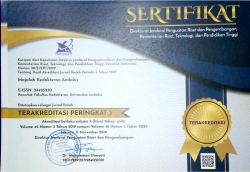Case Report of Esophageal Food Impaction in Partially Edentulous Patient
Abstract
Introduction: Esophageal food impactionis a medical ailment characterised by the obstruction of the oesophagus due to food becoming stuck. Loss of teeth can lead to food impaction, which lowers the ability to chew and create a bolus. This can cause bigger food particles that interfere with swallowing. Objective: Understanding diagnosis dan management of Esophageal Food Impaction in which partially Edentulous as risk factor. Case Report: A 60-year-old man came with complaints of having difficulty in swallowing since 3 days before admission. There was history of feeling something stuck in his throat after swallowing a chunk of meat. Oral cavity examination revealed missing 21 of teeth. There was standing secretion in pyriform sinus. The patient was managed with diagnostic and therapeutic esophagoscopy with diagnosis of impaction of "meat" food in the esophagus. A chunk of meat was removed at the level of 18 cm away from upper incisor. After removal, difficulty of swallowing was improved. Conclusion: Food bolus impaction “meat” can be successfully removed using rigid esophagoscopy without any complications. There was significant improvement in symptoms after removal of food impaction. Loss of teeth is a risk factor for food impaction in this case.
Keywords
Full Text:
PDFReferences
Melendez-Rosado J, Corral JE, Patel S, Badillo RJ, Francis D. Esophageal Food Impaction: Causes, Elective Intubation, and Associated Adverse Events. J Clin Gastroenterol. 2019;53(3):179–83.
Shikino K, Ikusaka M. Steakhouse syndrome. Clin Case Reports. 2021;9(6):9–10.
Ainani H, Arifin R, Wardani IK. Description of Partially Edentulous Pattern Among Patients At Rsgmp Gusti Hasan Aman in Banjarmasin. Dentino. 2021;6(1):100–4.
Balan GG, Sandru V, Savin C, Constantinescu G. Esophageal Food Bolus Impaction in Partially Edentulous Patients. a Cross-Sectional Study Over the Impact of Kennedy’S Classification System. Int J Med Dent. 2019;23(3):353–8.
Ooi M, Young EJ, Nguyen NQ. Effectiveness of a cap-assisted device in the endoscopic removal of food bolus obstruction from the esophagus. Gastrointest Endosc. 2018;87(5):1198–203.
To K, Adamson R. Food bolus/foreign body obstruction of the upper aerodigestive tract. In: Hussain SM, White P, See KA, Spielmann P, Montague M-L, editors. ENT Head & Neck Emergencies A Logan Turner Companion. New York: CRC Press; 2019. p. 107–9.
Morton R, Lilic N. Impacted Foreign Body in Airway. In: Morton RP, Ahmad Z, Giles M, editors. Symptom Oriented Otolaryngology Head and Neck Surgery: Head and Neck and Laryngology (Volume 1). New Delhi: Jaypee Brothers Medical Publishers (P) LTD; 2017. p. 439–439.
Long B, Koyfman A, Gottlieb M. Esophageal Foreign Bodies and Obstruction in the Emergency Department Setting: An Evidence-Based Review. J Emerg Med. 2019;56(5):499–511.
Mathew RP, Sarasamma S, Jose M, Toms A, Jayaram V, Patel V, et al. Clinical presentation, diagnosis and management of aerodigestive tract foreign bodies in the adult population: Part 1. South African J Radiol. 2021;25(1):1–13.
Pematilleke N, Kaur M, Adhikari B, Torley PJ. Relationship between masticatory variables and bolus characteristics of meat with different textures. J Texture Stud. 2021;52(5–6):552–60.
Pematilleke N, Kaur M, Adhikari B, Torley P. Influence of meat texture on oral processing and bolus formation. J Food Eng. 2020;1(1):1–9
Lebedová N, Bureš D, Needham T, Čítek J, Dlubalová Z, Stupka R, et al. Histochemical characterisation of high-value beef muscles from different breeds, and its relation to tenderness. Livest Sci. 2021;247(March).
Das J. Foreign Bodies in the Throat. In: Trauma in Otolaryngology. Singapore: Springer; 2018. p. 153–63.
Luo C, Lee Y, Cm L, Yc L. Diagnostic Accuracy of Lateral Neck Radiography for Esophageal Foreign Bodies in Adults. Am J Roentgenol. 2020;1(1):1–7.
Solowski N, Lintzenich CR, Postma GN. Esophagology. In: Wackym P ashley, Snow JB, editors. Ballanger’s otorhinolaryngology head and neck surgery. 18th Ed. USA: People’s medical publishing house; 2016. p. 1267–76.
Kavitt RT, Vaezi MF. Diseases of the Esophagus. In: Flint P, editor. Cummings Otolaryngology Head and Neck Surgery. 7th ed. Philadelphia: Elsevier; 2021. p. 964–91.
Wahed S, Griffin SM. Oesophageal Diseases. In: Watkinson J, Clarker R, editors. Scott-Brown’s Otorhinolaryngology Head & Neck Surgery Vol 1. 8th Ed. New York: CRC press; 2018. p. 826–42.
Ramos VF, Silva AF, Picinato-Pirola M. Masticatory function in elderly compared to young adults. Codas. 2022;34(1):1–7.
Bayram HM, Ilgaz F, Serel-Arslan S, Demir N, Rakicioglu N. The relationship between dysphagia, oral health, masticatory performance and activities of daily living in elderly individuals as assessed by the Eating Assessment Tool. Prog Nutr. 2021;23(1):1–8.
Nogueira D. Presbyphagia. In: Mankekar G, editor. Swallowing-Physiology, Disorders, Diagnosis and Therapy. New York: Springer; 2015. p. 189–218.





















